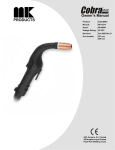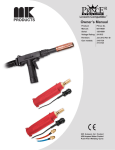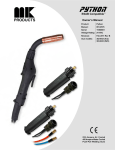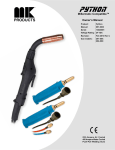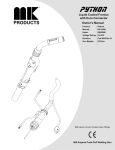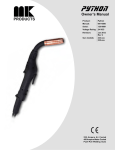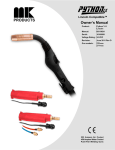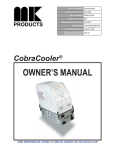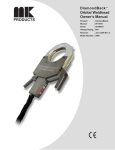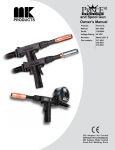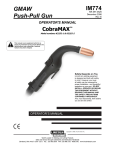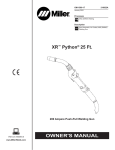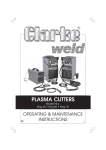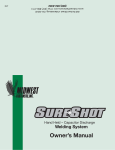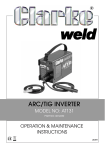Download Owner`s Manual
Transcript
Fronius Compatible™ Owner’s Manual Product: Cobra® SX Fronius Manual: 091-0646 Serial: 10090001 Voltage Rating: 24 VDC Revision: Sept 2010 Gun models: 328-8xx 175 Ampere Push-Pull Welding Gun Table of Contents Safety Considerations Installation................................................................................... Section A Technical Specifications..........................................................................................1 Support Equipment Required..................................................................................1 Gun Lead Connections...........................................................................................1 Operation.....................................................................................Section B General...................................................................................................................2 Controls and Settings..............................................................................................2 Drive Roll and Idler Rolls........................................................................................2 Accessories.................................................................................Section C Optional Kits............................................................................................................3 Snake Skins............................................................................................................3 Contact Tips............................................................................................................4 Gas Cups................................................................................................................4 Maintenance................................................................................Section D Periodic Maintenance.............................................................................................5 Maintenance Tools..................................................................................................5 Recommended Spare Parts List.............................................................................5 Troubleshooting...........................................................................Section E Troubleshooting Guide............................................................................................7 Testing The Gun......................................................................................................7 Appendices.................................................................................. Section F Diagrams / Parts List...............................................................................................9 Mechanical............................................................................................................10 Electrical...............................................................................................................17 Safety Warnings Warranty Cobra® SX Fronius Compatible Owner's Manual Declaration of Conformity for European Community (CE) Products Note This information is provided for units with CE certification (see rating label on unit). Manufacturer’s Name: MK Products, Inc. 16882 Armstrong Ave. Irvine, CA 92606 Declares that the product: Cobra® SX Fronius Compatible conforms to the following Directives and Standards: Directives Low Voltage Directive: 2006/95/EC Electromagnetic Compatibility (EMC) Directive: 2004/108/EC Standards Electromagnetic Compatibility, (EMC): EN 60974-10: 2007 Torches And Guns For Arc Welding, EN 60974-7: 2005 Cobra® SX Fronius Compatible Owner's Manual SAFETY CONSIDERATIONS ELECTRIC ARC WELDING EQUIPMENT CAUTION : READ BEFORE ATTEMPTING INSTALLATION, OPERATION OR MAINTENANCE OF THIS EQUIPMENT 1-1 INTRODUCTION This equipment is intended for ultimate application by commercial/industrial users and for operation by persons trained and experienced in the use and maintenance of welding equipment. Operation should not be undertaken without adequate training in the use of such equipment. Training is available from many public and private schools or similar facilities. Safe practices in the installation, operation and maintenance of this equipment requires proper training in the art, a careful study of the information provided with the equipment, and the use of common sense. Rules for safe use are generally provided by suppliers of welding power sources, compressed gas suppliers, and electrode suppliers. Careful compliance with these rules will promote safe use of this equipment. The following Safety Rules cover some of the more generally found situations. READ THEM CAREFULLY. In case of any doubt, obtain qualified help before proceeding. 1-2 GENERAL PRECAUTIONS A. Burn Prevention ELECTRIC ARC WELDING PRODUCES H I G H I N T E N S I T Y H E AT A N D ULTRAVIOLET RADIANT ENERGY WHICH MAY CAUSE SERIOUS AND PERMANENT EYE DAMAGE AND WHICH MAY DAMAGE ANY EXPOSED SKIN AREAS. Wear helmet with safety goggles or glasses with side shields underneath, appropriate filter lenses or plates (protected by clear cover glass). This is a must for welding or cutting (and chipping) to protect the eyes from radiant energy and flying metal. Replace cover glass when broken, pitted, or spattered. Medical first aid and eye treatment. First aid facilities and a qualified first aid person should be available for each shift unless medical facilities are close by for immediate treatment of flash burns of the eyes and skin burns. Wear protective clothing - leather (or asbestos) gauntlet gloves, hat, and high safety-toe shoes. Button shirt collar and pocket flaps, and wear cuffless trousers to avoid entry of sparks and slag. Avoid oily or greasy clothing. A spark may ignite them. Flammable hair preparations should not be used by persons intending to weld or cut. Hot metal such as electrode stubs and work pieces should never be handled without gloves. Ear plugs should be worn when working on overhead or in a confined space. A hard hat should be worn when others work overhead. B. Toxic Fume Prevention WARNING: The use of this product may result in exposure to chemicals known to the State of California to cause cancer and birth defects or other reproductive harm. Adequate ventilation. Severe discomfort, illness or death can result from fumes, vapors, heat, or oxygen enrichment or depletion that welding (or cutting) may produce. Prevent them with adequate ventilation. NEVER ventilate with oxygen. circuits. If combustibles are in area, do NOT weld or cut. Move the work if practicable, to an area free of combustibles. Avoid paint spray rooms, dip tanks, storage areas, ventilators. If the work cannot be moved, move combustibles at least 35 feet away, out of reach of sparks and heat; or protect against ignition with suitable and snugfitting, fire-resistant covers or shields. Lead-, cadmium-, zinc-, mercury-, beryllium-bearing and similar materials, when welded or cut, may produce harmful concentrations of toxic fumes. Adequate local exhaust ventilation must be used, or each person in the area, as well as the operator, must wear an air-supplied respirator. For beryllium, both must be used. Walls touching combustibles on opposite sides should not be welded on (or cut). Walls, ceilings, and floor near work should be protected by heat-resistant covers or shields. Metals coated with or containing materials that emit toxic fumes should not be heated unless coating is removed form the work surface, the area is well ventilated, or the operator wears an airsupplied respirator. 1. Appreciable combustibles (including building construction) are within 35 feet. Work in a confined space only while it is being ventilated and, if necessary, while wearing an air-supplied respirator. 3. Openings (concealed or visible) in floors or walls within 35 feet may expose combustibles to sparks. Gas leaks in a confined space should be avoided. Leaked gas in large quantities can change oxygen concentration dangerously. Do not bring gas cylinders into a confined space. 4. Combustibles adjacent to walls, ceilings, roofs, or metal partitions can be ignited by radiant or conducted heat. Leaving confined space, shut OFF gas supply at source to prevent possible accumulation of gases in the space if downstream valves have been accidentally opened or left open. Check to be sure that the space is safe before reentering it. Vapors from chlorinated solvents can be decomposed by the heat of the arc (or flame) to form PHOSGENE, a highly toxic gas, and other lung and eye irritating products. The ultraviolet (radiant) energy of the arc can also decompose trichloroethylene and perchloroethylene vapors to form phosgene. DO NOT WELD or cut where solvent vapors can be drawn into the welding or cutting atmosphere or where the radiant energy can penetrate to atmospheres containing even minute amounts of trichloroethylene or perchloroethylene. C. Fire and Explosion Prevention Causes of fire and explosion are: combustibles reached by the arc, flame, flying sparks, hot slag, or heated material, misuse of compressed gases and cylinders, and short circuits. BE AWARE THAT flying sparks or falling slag can pass through cracks, along pipes, through windows or doors, and through wall or floor openings, out of sight of the goggled operator. Sparks can fly many feet. To prevent fires and explosion: Keep equipment clean and operable, free of oil, grease, and (in electrical parts) of metallic particles that can cause short Fire watcher must be standing by with suitable fire extinguishing equipment during and for some time after welding or cutting if: 2. Appreciable combustibles are further than 35 feet, but can be ignited by sparks. Hot work permit should be obtained before operation to ensure supervisor’s approval that adequate precautions have been taken. After work is done, check that area is free of sparks, glowing embers, and flames. An empty container that held combustibles, or that can produce flammable or toxic vapors when heated, must never be welded on or cut, unless container has first been cleaned in accordance with industry standards. This includes: a thorough steam or caustic cleaning (or a solvent of water washing, depending on the combustible’s solubility), followed by purging and inerting with nitrogen or carbon dioxide, and using protective equipment. Water-filling just below working level may substitute for inerting. A container with unknown contents should be cleaned (see paragraph above). Do NOT depend on sense of smell or sight to determine if it is safe to weld or cut. Hollow castings or containers must be vented before welding or cutting. They can explode. Explosive atmospheres. NEVER weld or cut where the air may contain flammable dust, gas, or liquid vapors (such as gasoline). D. Compressed Gas Equipment The safe handling of compressed gas equipment is detailed in numerous industry publications. The following general rules cover many of the most common situations. Cobra® SX Fronius Compatible™ Owner's Manual - Page i 1. Pressure Regulators Regulator relief valve is designed to protect only the regulator from overpressure; it is not intended to protect any downstream equipment. Provide such protection with one or more relief devices. Never connect a regulator to a cylinder containing gas other than that for which the regulator was designed. Remove faulty regulator from service immediately for repair (first close cylinder valve). The following symptoms indicate a faulty regulator: Leaks - if gas leaks externally. Excessive Creep - if delivery pressure continues to rise with downstream valve closed. Faulty Gauge - if gauge pointer does not move off stop pin when pressurized, nor returns to stop pin after pressure release. Repair. Do NOT attempt repair. Send faulty regulators for repair to manufacturer’s designated repair center, where special techniques and tools are used by trained personnel. exposure exists. Protect cylinders, particularly valves from bumps, falls, falling objects, and weather. Replace caps securely when moving cylinders. Stuck valve. Do NOT use a hammer or wrench to open a cylinder valve that cannot be opened by hand. Notify your supplier. Mixing gases. NEVER try to mix any gases in a cylinder. NEVER refill any cylinder. Cylinder fittings should never be modified or exchanged. 3. Hose Prohibited use. Never use hose other than that designed for the specified gas. A general hose identification rule is: red for fuel gas, green for oxygen, and black for inert gases. Use ferrules or clamps designed for the hose (not ordinary wire or other substitute) as a binding to connect hoses to fittings. No copper tubing splices. Use only standard brass fittings to splice hose. 2. Cylinders Cylinders must be handled carefully to prevent leaks and damage to their walls, valves, or safety devices: Avoid long runs to prevent kinks and abuse. Suspend hose off ground to keep it from being run over, stepped on, or otherwise damaged. Avoid electrical circuit contact with cylinders including third rails, electrical wires, or welding circuits. They can produced short circuit arcs that may lead to a serious accident. (See 1-3C) Coil excess hose to prevent kinks and tangles. ICC or DOT marking must be on each cylinder. It is an assurance of safety when the cylinder is properly handled. Examine hose regularly for leaks, wear, and loose connections. Immerse pressured hose in water; bubbles indicate leaks Identifying gas content. Use only cylinders with name of gas marked on them; do not rely on color to identify gas content. Notify supplier if unmarked. NEVER DEFACE or alter name, number, or other markings on a cylinder. It is illegal and hazardous. Empties: Keep valves closed, replace caps securely; mark MT; keep them separate from FULLS, and return promptly. Prohibited use. Never use a cylinder or its contents for other than its intended use, NEVER as a support or roller. Locate or secure cylinders so they cannot be knocked over. Passageways and work areas. Keep cylinders clear of areas where they may be stuck. Protect hose from damage by sharp edges, and by sparks, slag, and open flame. Repair leaky or worn hose by cutting area out and splicing. Do NOT use tape. 4. Proper Connections Clean cylinder valve outlet of impurities that may clog orifices and damage seats before connecting regulator. Except for hydrogen, crack valve momentarily, pointing outlet away from people and sources of ignition. Wipe with a clean, lintless cloth. Match regulator to cylinder. Before connecting, check that the regulator label and cylinder marking agree, and that the regulator inlet and cylinder outlet match. NEVER Connect a regulator designed for a particular gas or gases to a cylinder containing any other gas. Transporting cylinders. With a crane, use a secure support such as a platform or cradle. Do NOT lift cylinders off the ground by their valves or caps, or by chains, slings, or magnets. Tighten connections. When assembling threaded connections, clean and smooth seats where necessary. Tighten. If connection leaks, disassemble, clean, and retighten, using properly fitting wrench. Do NOT expose cylinders to excessive heat, sparks, slag, and flame, etc. that may cause rupture. Do not allow contents to exceed 55 degrees C (130 degrees F.) Cool with water spray where such Adapters. Use a CGA adapter (available from your supplier) between cylinder and regulator, if one is required. Use two wrenches to tighten adapter marked RIGHT and LEFT HAND threads. Regulator outlet (or hose) connections may be identified by right hand threads for oxygen and left hand threads (with grooved hex on nut or shank) for fuel gas. 5. Pressurizing Steps: Drain regulator of residual gas through suitable vent before opening cylinder (or manifold valve) by turning adjusting screw in (clockwise). Draining prevents excessive compression heat at high pressure seat by allowing seat to open on pressurization. Leave adjusting screw engaged slightly on single-stage regulators. Stand to side of regulator while opening cylinder valve. Open cylinder valve slowly so that regulator pressure increases slowly. When gauge is pressurized (gauge reaches regulator maximum) leave cylinder valve in following position: for oxygen and inert gases, open fully to seal stem against possible leak; for fuel gas, open to less than one turn to permit quick emergency shut-off. Use pressure charts (available from your supplier) for safe and efficient recommended pressure settings on regulators. Check for leaks on first pressurization and regularly thereafter. Brush with soap solution. Bubbles indicate leaks. Clean off soapy water after test; dried soap is combustible. E. User Responsibilities Follow all Safety Rules. Remove leaky or defective equipment from service immediately for repair. Read and follow user manual instructions. F. Leaving Equipment Unattended Close gas supply at source and drain gas. G. Rope Staging-Support Rope staging-support should not be used for welding or cutting operation; rope may burn. 1-3 ARC WELDING Comply with precautions in 1-1, 1-2, and this section. Arc Welding, properly done, is a safe process, but a careless operator invites trouble. The equipment carries high currents at significant voltages. The arc is very bright and hot. Sparks fly, fumes rise, ultraviolet and infrared energy radiates, weldments are hot, and compressed gases may be used. The wise operator avoids unnecessary risks and protects himself and others from accidents. A. Burn Protection Comply with precautions in 1-2. The welding arc is intense and visibly bright. Its radiation can damage eyes, penetrate lightweight clothing, reflect from light-colored surfaces, and burn the skin and eyes. Skin burns resemble acute sunburn; those from gas-shielded arcs are more severe and painful. Cobra® SX Fronius Compatible™ Owner's Manual - Page ii DON’T GET BURNED; COMPLY WITH PRECAUTIONS. 1. Protective Clothing Wear long-sleeve clothing in addition to gloves, hat, and shoes. As necessary, use additional protective clothing such as leather jacket or sleeves, flameproof apron, and fire-resistant leggings. Avoid outer garments of untreated cotton. Bare skin protection. Wear dark, substantial clothing. Button collar to protect chest and neck, and button pockets to prevent entry of sparks. 2. Eye and Head Protection Protect eyes from exposure to arc. Eyes may be damaged by radiant energy when exposed to the electric arc, even when not looking in the direction of the arc. Never look at an electric arc without protection. Welding helmet or shield containing a filter plate shade no. 12 or denser must be used when welding. Place over face before striking arc. Protect filter plate with a clear cover plate. Cracked or broken helmet or shield should NOT be worn; radiation can be passed through to cause burns. Cracked, broken, or loose filter plates must be replaced IMMEDIATELY. Replace clear cover plate when broken, pitted, or spattered. Flash goggles with side shields MUST be worn under the helmet to give some protection to the eyes should the helmet not be lowered over the face before an arc is struck. Looking at an arc momentarily with unprotected eyes (particularly a high intensity gas-shielded arc) can cause a retinal burn that may leave a permanent dark area in the field of vision. 3. Protection of Nearby Personnel Enclose the welding area. For production welding, a separate room or enclosed bay is best. In open areas, surround the operation with low-reflective, noncombustible screens or panels. Allow for free air circulation, particularly at floor level. Viewing the weld. Provide face shields for all persons who will be looking directly at the weld. Others working in area. See that all persons are wearing flash goggles. Before starting to weld, make sure that screen flaps or bay doors are closed. B. Toxic Fume Prevention Comply with precautions in 1-2B. Generator engine exhaust must be vented to the outside air. Carbon monoxide can kill. C. Fire and Explosion Prevention Comply with precautions in 1-2C. Equipment’s rated capacity. Do not overload arc welding equipment. It may overheat cables and cause a fire. Loose cable connections may overheat or flash and cause afire. Never strike an arc on a cylinder or other pressure vessel. It creates a brittle area that can cause a violent rupture or lead to such a rupture later under rough handling. D. Compressed Gas Equipment Comply with precautions in 1-2D. E. Shock Prevention Exposed electrically hot conductors or other bare metal in the welding circuit, or in ungrounded, electrically-HOT equipment can fatally shock a person whose body becomes a conductor. DO NOT STAND, SIT, LIE, LEAN ON, OR TOUCH a wet surface when welding without suitable protection. To protect against shock: Keep body and clothing dry. Never work in damp area without adequate insulation against electrical shock. Stay on a dry duckboard, or rubber mat when dampness or sweat cannot be avoided. Sweat, sea water, or moisture between body and an electrically HOT part or grounded metal - reduces the body surface electrical resistance, enabling dangerous and possibly lethal currents to flow through the body. 1. Grounding the Equipment When installing, connect the frames of each unit such as welding power source, control, work table, and water circulator to the building ground. Conductors must be adequate to carry ground currents safely. Equipment made electrically HOT by stray currents may shock, possibly fatally. Do NOT GROUND to electrical conduit, or to a pipe carrying ANY gas or a flammable liquid such as oil or fuel. Three-phase connection. Check phase requirement of equipment before installing. If only three-phase power is available, connect single-phase equipment to only two wires of the three-phase line. Do NOT connect the equipment ground lead to the third (live) wire, or the equipment will become electrically HOT - a dangerous condition that can shock, possibly fatally. 3. Cables Frequently inspect cables for wear, cracks, and damage. IMMEDIATELY REPLACE those with excessively worn or damaged insulation to avoid possibly lethal shock from bared cable. Cables with damaged areas may be taped to give resistance equivalent to original cable. Keep cable dry, free of oil and grease, and protected from hot metal and sparks. 4. Terminals and Other Exposed Parts Terminals and other exposed parts of electrical units should have insulating covers secured before operation. 5. Electrode Wire Electrode wire becomes electrically HOT when the power switch of gas metal-arc welding equipment is ON and welding gun trigger is pressed. Keep hands and body clear of wire and other HOT parts. 6. Safety Devices Safety devices such as interlocks and circuit breakers should not be disconnected or shunted out. Before installation, inspection, or service of equipment, shut OFF all power, and remove line fuses (or lock or red-tag switches) to prevent accidental turning ON of power. Disconnect all cables from welding power source, and pull all 115 volts line-cord plugs. Do not open power circuit or change polarity while welding. If, in an emergency, it must be disconnected, guard against shock burns or flash from switch arcing. Leaving equipment unattended. Always shut OFF, and disconnect all power to equipment. Power disconnect switch must be available near the welding power source. Before welding, check ground for continuity. Be sure conductors are touching bare metal of equipment frames at connections. If a line cord with a ground lead is provided with the equipment for connection to a switch box, connect the ground lead to the grounded switch box. If a threeprong plug is added for connection to a grounded mating receptacle, the ground lead must be connected to the ground prong only. If the line cord comes with a three-prong plug, connect to a grounded mating receptacle. Never remove the ground prong from a plug, or use a plug with a broken ground prong. 2. Connectors Fully insulated lock-type connectors should be used to join welding cable lengths. Cobra® SX Fronius Compatible™ Owner's Manual - Page iii Thank You For selecting a quality product. We want you to take pride in operating this product...as much pride as we have in bringing the product to you! Please Examine Carton and Equipment For Damage Immediately When this equipment is shipped, title passes to the purchaser upon receipt by the carrier. Consequently, claims for material damaged in shipment must be made by the purchaser against the transportation company at the time the shipment is received. Please record your equipment identification information below for future reference. This information can be found on your machine nameplate. Model Name & Number _____________________ Code & Serial Number _____________________ Date of Purchase _____________________ Whenever you request replacements parts for, or information on this equipment always supply the information you have recorded above. Read this Owner’s Manual completely before attempting to use this equipment. Save this manual and keep it handy for quick reference. Pay particular attention to the safety instructions we have provided for your protection. Cobra® SX Fronius Compatible Owner's Manual Section A Installation Technical Specifications Wire Capacity .030” - .035” (0.6mm - 0.9mm) Solid and hard wires .030” - 3/64” (0.8mm - 1.6mm) Aluminum .023" (0.6mm) capability using Optional Idler Roll, P/N 511-0113 Wire Speed 800 IPM (20.3 mpm) Max. at rated feeder Input Voltage (120VAC / 42VAC) Duty Cycle All ratings are using Argon Gas 175 Amps/25 Volts 60% Support Equipment Required • C.V. or C.C. Power Source of sufficient capacity for your needs. • Regulated gas supply and hoses. • Properly sized power leads from power source to wire feeder and ground. Gun Lead Connections Power Cable A #2 power cable is used on the Cobra® SX Fronius Compatible™ gun. The gun and Power Pin ends of the cable are stripped to the copper strands and wrapped with a copper strip. A setscrew holds the cable securely in the gun body and in the Power Manifold with torque requirements of 55-60 in-lb. Conduit The Cobra® SX Fronius Compatible™ comes standard with a poly-lined conduit, for feeding aluminum wire. The longer fitting with a shallow groove is used on the gun end. A set screw located on top of the gun handle secures the conduit in place. The cabinet end of the conduit is secured into the Power Pin connector with a set screw. Gas Hose The gas hose is pushed over a barbed fitting on the end of the gun body and secured by twisting the hose retainer to the end of the hose (shown below). The hose retainer is re-usable and can be removed and re-installed as needed. Control Cable A multi-conductor control cable is used on the Cobra® SX Fronius Compatible™ gun. The gun end of the cable is secured with a cable clamp and the wires are connected to the potentiometer, the micro switch, the motor and the gun body mechanically. Slack is left in the electric cable as it exits the back of the gun to prevent cable and/or wire breakage. The cabinet end of the control cable uses a 9-Pin, rectangular connector. Cobra® SX Fronius Compatible™ Owner's Manual - Page 1 Section B Operation General The Cobra® SX Fronius Compatible™ gun maintains a constant, steady, uniform wire feed speed, regardless of curved or looped wire conduit. The constant push exerted by the slave motor in the cabinet, combined with the pull of the gun motor, causes the wire to literally float friction-free through the wire conduit. The 24VDC gun motor is controlled by a three and threequarter (3 3/4) turn potentiometer in the gun handle. Controls and Settings Potentiometer The laterally-positioned potentiometer is located in the lower end of the handle, providing up to 800 ipm with 3 3/4 turns. Micro Switch The micro switch assembly consists of the micro switch and leads. Trigger Sensitivity The amount of trigger lever travel can be shortened for a “quicker” or “more responsive” action. A more sensitive trigger lever is produced by reducing the gap between the trigger lever and the micro-switch lever. By turning-in the Trigger Sensivity Adjustment Screw (Figure 1), it closes the gap between the trigger lever and the microswitch lever. This will enable the operator to increase the sensivity of the trigger lever. Figure 1 Sensitivity Adjustment With the wire feeder turned on (with or without welding wire loaded), turn the screw in until the micro-switch is activated (Figure 2). Once Figure 2 activated, the gun and wire feeder motors will begin feeding wire. Retract the screw accordingly until the system is deactivated and adjusted to the operators’ liking. Drive Roll and Idler Rolls General The Cobra® SX Fronius Compatible™ gun comes standard with a knurled drive roll and a grooved idler roll, ready for welding aluminum wire diameters from .030” up to 3/64”. An optional grooved idler roll, for wire diameter .023” is available as P/N 511-0113. Insulated V-Groove drive roll kits are also available for aluminum wire, (see Optional Kits). Drive roll tension is accomplished with a unique spring-loaded pressure screw. The Cobra® SX Fronius Compatible™ comes from the factory with the pressure adjustment screw preset. NO ADJUSTMENT is required for all sizes and types of wires. Drive Roll Installation/Removal Note: Neither of the handles needs to be removed to access the Drive or Idler Rolls 1. Push the idler lever, this will relieve the pressure against the drive roll (as shown in Figure 3). 2. Align the Drive Roll Removal Tool (P/N 931-0100) over the flats of the drive roll (as shown in Figure 4). Hold the gun with one hand or on a table top, with the other hand give the Removal Tool a quick snap-turn in the CLOCKWISE DIRECTION. Cobra® SX Fronius Compatible™ Owner's Manual - Page 2 Figure 4 Figure 3 3. Once the drive roll is loose, continue to spin drive roll in the clockwise direction to remove the drive roll from the gun. 4. Install a new drive roll on the left-hand threaded shaft. The drive roll will self-tighten when it is feeding wire. Idler Roll Installation and Removal (Reference Figure 5) 1. Using a slot type screwdriver, loosen idler screw. 2. Insert new idler roll onto screw, insuring that idler groove is toward top. 3. Tighten. Figure 5 Section C Accessories Optional Kits The arcing of the wire at the knurled drive roll is typical of a contact tip which is too large for the wire or if the aluminum wire has excessive oxidation, reducing the contact between the wire and contact tip. Insulated Drive Roll Kits are used when the teeth on the knurled drive roll, arc to and soften the wire as it enters the barrel liner. The softened wire has a greater potential of being shaved and/or clogging in the barrel liner. Insulated Groove Drive Roll Kit.......................................................005-0640 For .030" (0.8mm) dia. aluminum wire. Includes insulated drive roll and idler roll assy. Insulated Groove Drive Roll Kit.......................................................005-0716 For .035" (0.9mm) dia. aluminum wire. Includes insulated drive roll and idler roll assy. Insulated Groove Drive Roll Kit.......................................................005-0717 For .040" (1.0mm) dia. aluminum wire. Includes insulated drive roll and idler roll assy. Insulated Groove Drive Roll Kit.......................................................005-0718 For 3/64" (1.2mm) dia. aluminum wire. Includes insulated drive roll and idler roll assy. Snake Skins Snake Skin protective covers are standard on the Cobra® SX Fronius Compatible™. Replacement covers may be ordered and replaced in the field by means of hook and loop - also known as Velcro®. Snake Skin Cover 15ft leads........................................................931-0110 Snake Skin Cover 25ft leads....................................................... 931-0122 Snake Skin Cover 35ft leads....................................................... 931-0132 Snake Skin Cover 50ft leads....................................................... 931-0123 Cobra® SX Fronius Compatible™ Owner's Manual - Page 3 Conduits flat spiral steel conduit for steel & cored wire 615-0621-15..................................................................................... 15 ft./4.5m 615-0621-25..................................................................................... 25 ft./7.6m 615-0621-35................................................................................... 35 ft./10.7m 615-0621-50................................................................................... 50 ft./15.2m Contact Tips 1/4" Diameter Contact Tip* Wire Size Tip ID Arc Tip Length .023” (0.6 mm) .023” (0.6 mm) .030” (0.8 mm) .030” (0.8 mm) .030” (0.8 mm) .035” (0.9 mm) .031” (0.8 mm) .031” (0.8 mm) .037” (0.9 mm) .037” (0.9 mm) .040” (1.0 mm) .045” (1.1 mm) Spray Short Spray Short Spray Spray 1.50” (38.1 mm) 1.75” (44.5 mm) 1.50” (38.1 mm) 1.75” (44.5 mm) 1.50” (38.1 mm) 1.50” (38.1 mm) .035” (0.9 mm) .035” (0.9 mm) 3/64” (1.2 mm) 3/64” (1.2 mm) .040” (1.0 mm) .045” (1.1 mm) .054” (1.37 mm) .060” (1.5 mm) Short Short Spray Spray 1.75” (44.5 mm) 1.75” (44.5 mm) 1.50” (38.1 mm) 1.50” (38.1 mm) **This size tip furnished with gun * All tips sold in quantities of 25 † Part No. 621-0057-25 621-0328-25 621-0325-25 621-0326-25 621-0076-25 621-0001-25 621-0001-250 621-0001-500 621-0077-25 621-0002-25 621-0327-25 621-0003-25 621-0003-250 621-0003-500 Also sold in quantities of 250 Gas Cups Cup Size Gas Cups Cup I.D. Part No. No. 5 1/4" (6.4mm) 621-0079 No. 6 3/8” (9.5mm) 001-0137† No. 8 1/2” (12.7mm) 001-0138*† No. 10 5/8” (15.8mm) 001-0139† *standard - furnished with gun † sold in packs of 4 each Gun Barrel Liners Part Number Description 931-0137 Teflon liner package, 5 pieces 615-0255 Spiral steel, .030 - .045” (0.8mm - 1.1mm) 621-0017 Tip Extender, Classic Cup, 1/4" Tip (Stackable) 615-0256 Spiral liner for tip extender Cobra® SX Fronius Compatible™ Owner's Manual - Page 4 Section D Maintenance Periodic Maintenance Your Cobramatic System is designed to provide years of reliable service. Maintenance of the gun will normally consist of a general cleaning of the wire guide system, including barrel, drive rolls, and conduit at regular intervals. Remove spatter build-up from inside of nozzles with a hardwood stick. It is recommended that the conduit be blown out every time you add a new spool of wire. The only parts on the Cobramatic system that are subject to normal wear are the conduit, contact tips, gas cups, front body liners, wire guides, drive and idler rolls. A supply of these parts should be maintained on hand. The number of units in operation and the importance of minimal “down time” will determine to what extent spare parts should be stocked on hand. See the “Recommended spare parts list” for the most commonly replaced parts. If repairs do become necessary, qualified shop maintenance personnel can easily replace any part. Maintenance Tools Tool Part Number Drive Roll Removal Tool 931-0100 Qty. 1 1 1 1 1 1 1 1 2 2 Recommended Spare Parts List P/N Description 615-0620-15 615-0620-25 615-0620-35 615-0620-50 005-0694 003-2190 005-0710 003-2197 511-0101 511-0001 Conduit 15 ft Conduit 25 ft Conduit 35 ft Conduit 50 ft Trigger Assy Kit Potentiometer Assembly Handle Kit Micro Switch Assembly Drive Roll Idler Roll DRIVE ROLL REMOVAL TOOL 931-0100 KNURLED DRIVE ROLL 511-0101 IDLER ROLL 511-0001 (.030" - 3/64") IDLER ROLL 511-0113 (.023") MICRO SWITCH ASSY 003-2197 Cobra® SX Fronius Compatible™ Owner's Manual - Page 5 Section E Troubleshooting Trouble Remedy Cause No wire feed at gun, feeder not operating, I.e. no slave motor or brake solenoid. No wire feed at gun, feeder operating properly Input power fuse in feeder/ Control box blown. Replace fuse. Micro-switch defective/not being activated. Replace switch. Check switch for operation. Broken electrical cable. Check micro-switch wires for continuity Motor Control fuse in feeder/ Control box blown. Check motor leads for shorts; then replace fuse. Bad potentiometer. Check potentiometer with meter. Broken electrical cable. Check motor and potentiometer wires for continuity. Bad speed control/PCB. See specific cabinet/control box owners for speed control operation. Loose or no cable connections. Check all power connections. Contactor control cable loose or Check power supply owners manual for location and type of Wire feeds, but welding wire in wrong position. contactor signal required, i.e., is not engergized. closing or 115VAC. Wire feeds erratically. Welding power source. Check power source. Dirty or worn conduit. Blow out or replace conduit. Wrong size contact tip. See contact tip table. Idler roll stuck. Check for lock washer under idler roll, or replace if damaged. Bad potentiometer. Check with meter. Broken electrical cable. Check potentiometer wires for continuity or short. Bad speed control. See specific cabinet/control box owners for speed control operation. Idler roll upside-down. Place groove in idler roll toward top. Rear wire guide missing. Replace wire guide. Wire feeds one speed only. Wire walks out of drive rolls. Cobra® SX Fronius Compatible™ Owner's Manual - Page 6 Troubleshooting Guide Regardless of which gun or feeder used, all MK Products’ push-pull guns operate on the same principle. The slave motor in the feeder runs at a fast, constant torque, but has very low torque. It is always trying to feed more wire than the gun motor wants, and when the motor gets all it wants, it slows the slave motor, preventing a bird’s nest. Because of the low torque produced by the slave motor, a brake system is used to prevent wire overrun rather than tension. The drag adjustment in the feeder is used simply to keep the wire slightly taut, so it will not pull off the spool while feeding wire. The high torque 24VDC gun motor is controlled by a solid state speed control located in the feeder, and a pot located in the gun. The gun motor, potentiometer, and micro switch are connected to the cabinet/control box via a control cable and Amphenol connector. If this cable becomes damaged, a variety of symptoms can occur, depending on which wire(s) break. To test, check each wire for continuity and shorts. Remember, the micro switch in the gun activates both the slave motor and gun motor circuits in the cabinet. Therefore, if the slave motor and brake solenoid operate, but the gun does not, look more toward the gun motor’s 24 V circuits, speed control, control cable, or the gun motor. If nothing operates, look more toward the slave motor’s input, micro switch leads, or micro switch. Testing The Gun Reference the 9-pin rectangular diagram on the Cobra® SX Fronius Compatible™ electrical diagram for information about pin-outs and locations. Motor Check Remove the connector from the cabinet. Using the 9-pin connector, check the resistance across pins “1” and “6” (motor leads). If an open circuit (more than K ohms) or short (less than 2 ohms) exists, check the motor leads and motor independently. Testing the Gun Potentiometer Using the 9-pin connector, check the resistance across pin “3” (wiper) and pin “2”. The resistance should vary from 0 - 5K ohms as the potentiometer is turned. Check the resistance across pin “3” (wiper) and pin “7”. The resistance should vary from 5K - 0 ohms as the potentiometer is turned. Testing the Micro Switch Using the 9-pin connector, check for continuity across pins “9” and “5” when the trigger is pressed. Cobra® SX Fronius Compatible™ Owner's Manual - Page 7 THIS PAGE INTENTIONALLY BLANK Cobra® SX Fronius Compatible™ Owner's Manual - Page 8 Section F Appendices And Diagrams / Parts List Exploded View . . . . . . . . . . . . . . . . . . . . . . . . . . . . . . . . . . . . . 10 Front Body Assembly . . . . . . . . . . . . . . . . . . . . . . . . . . . . . . . . 12 Rear Body Assembly . . . . . . . . . . . . . . . . . . . . . . . . . . . . . . . . 13 Classic Cup Assembly . . . . . . . . . . . . . . . . . . . . . . . . . . . . . . . 14 Lead Assembly . . . . . . . . . . . . . . . . . . . . . . . . . . . . . . . . . . . . 15 Power Manifold Assembly . . . . . . . . . . . . . . . . . . . . . . . . . . . . 16 Wiring Diagram . . . . . . . . . . . . . . . . . . . . . . . . . . . . . . . . . . . . 17 Cobra® SX Fronius Compatible™ Owner's Manual - Page 9 APPLY LOW STRENGTH THREAD LOCKING TO CONTACT SURACE APPLY COMPOUND NAOLOX TO EXTERNAL THREAD Cobra® SX Fronius Compatible™ Exploded View Cobra® SX Fronius Compatible™ Owner's Manual - Page 10 Cobra® SX Fronius Compatible™ Owner's Manual - Page 11 4 4 9 1 5 8 1 4 - 1 3 1 1 2 7 1 1 6 Qty. No. 333-0006 333-0003 003-2244 - 003-2197 003-2192 003-2191 003-2190 005-0694 Part No. Wshr Spr Lk #8 Wshr Spr Lk #4 Assy Rear Body - Assy Switch Assy Motor Assy Body Assy Potentiometer Trigger Kit Description 18 17 16 15 14 13 12 11 10 No. 1 1 1 1 4 2 4 11 Qty. Cobra® SX Fronius Compatible™ Parts List 437-0292 005-0710 431-1760 421-0713 338-0159 338-0153 338-0034 338-0014 Part No. Door Molded Handle Kit: Includes line items 10, 15, and 18 SCR Shoulder 1/8 x 4-40 Pin Dowel 3/32 x 3/4 SST SCR SHC M3 x 6 SST SCR SHC 1-72 x 3/8 SCR SHC 8-32 x 1/2 SST SCR SHC 4-40 x 1/2 SST Description Cobra® SX Fronius Compatible™ Front Body Assembly 003-2191 Front Body Assembly No. Qty. Part Number Description 1 1 325-0206 SCR Pan 10-24x.34 2 1 419-0120 Comp Spring 3 1 431-1728 SCR SH.093x4-40 4 - - Not Available Separately 5 1 431-1731 Idler Arm/Lever 6 1 511-0101 Drive Roll 7 1 511-0001 Idler Roll (.030" - 3/64") 7 opt 511-0113 Idler Roll (.023" - .035") Cobra® SX Fronius Compatible™ Owner's Manual - Page 12 Cobra® SX Fronius Compatible™ Rear Body Assembly 003-2244 Rear Body Assembly No. Qty. Part Number Description 1 - - Not Available Separately 2 2 303-0097 0-Ring 2-005 3 1 321-0518 SCR 1/4-20x3/8 4 1 321-1104 Conduit SCR Cobra® SX Fronius Compatible™ Owner's Manual - Page 13 Cobra® SX Fronius Compatible™ Classic Cup Barrel Assembly 003-2340 Classic Cup Barrel Assembly No. Qty. Part No. Description 1 1 001-0138 #8 Assy Gas Cup 2 - - Not available separately 3 1 301-0101 Barrel Insulator 4 2 303-0097 O-Ring 2-005 5 1 pkg. 931-0137 Barrel Liner PK, 5 pcs 6 1 621-0001 Tip, .045 x .25 OD Cobra® SX Fronius Compatible™ Owner's Manual - Page 14 Cobra® SX Fronius Compatible™ Lead Assembly Lead Assembly - Air Cooled No. Qty. Description 15' Part No. 25' Part No. 35' Part No. 1 1 Assy Boot Torch 003-2153 2 1 Assy Power Manifold, A/C 003-2373 3 2 Wrap Spiral Cord 261-0094 4 1 Retainer Ring 5 4 Screw SHC 4-40 x 1/2 SST 338-0014 6 4 Tie Wrap 411-0045 7 1 Conduit Liner Fitting 431-1788 8 2 Hose Retainer, 5/16 431-1898 9 1 Nut Handle Adapter 437-0265 10 1 Handle RH Lead Universal 437-0315-BLACK 11 1 Handle LH Lead Universal 437-0316-BLACK 50' Part No. 313-0140-1.062 12 1 Snake Skin 13 1 Assy Gas Hose 552-0241-15 552-0241-25 552-0241-35 552-0241-50 931-0110 931-0122 14 1 Conduit Tef Tube 615-0620-15 615-0620-25 615-0620-35 615-0620-50 15 1 Assy Controller Cable 005-0381-15 005-0381-25 005-0381-35 005-0381-50 16 1 Assy Power Cable Global 843-0640-15 843-0640-25 843-0640-35 843-0640-50 * Hose Retainer is re-usable and can be removed and re-installed as needed Cobra® SX Fronius Compatible™ Owner's Manual - Page 15 931-0132 931-0123 Cobra® SX Fronius Compatible™ Power Manifold Assembly, Air Cooled P/N 003-2373 APPLY HIGH STRENGTH THREAD SEALANT TO THREADS Power Manifold Assembly No. Qty. Part No. 1 3 303-0097 O-Ring Buna-N .101 ID x .07W 2 1 321-1082 Set Screw Flat 1/4 - 20 x 3/8 SST 3 1 321-1104 Set Screw Conduit 4 1 431-1905 Fitting 1/8 ID x 1/16 - 27 NPT 5 1 431-1948 Connector Thread 6 - - Description Not available separately Cobra® SX Fronius Compatible™ Owner's Manual - Page 16 Cobra® SX Fronius Compatible™ Electrical Cobra® SX Fronius Compatible™ Owner's Manual - Page 17 Cobra® SX Fronius Compatible Owner's Manual Cobra® SX Fronius Compatible Owner's Manual 16882 Armstrong Ave. Irvine, CA 92606 Tel (949)863-1234 Fax (949)474-1428 www.mkproducts.com Cobra® SX Fronius Compatible Owner's Manual August 1, 2010 THIS PAGE INTENTIONALLY BLANK 16882 Armstrong Ave. Irvine, California 92606 TEL (949) 863-1234 FAX (949) 474-1428 www.mkproducts.com






























